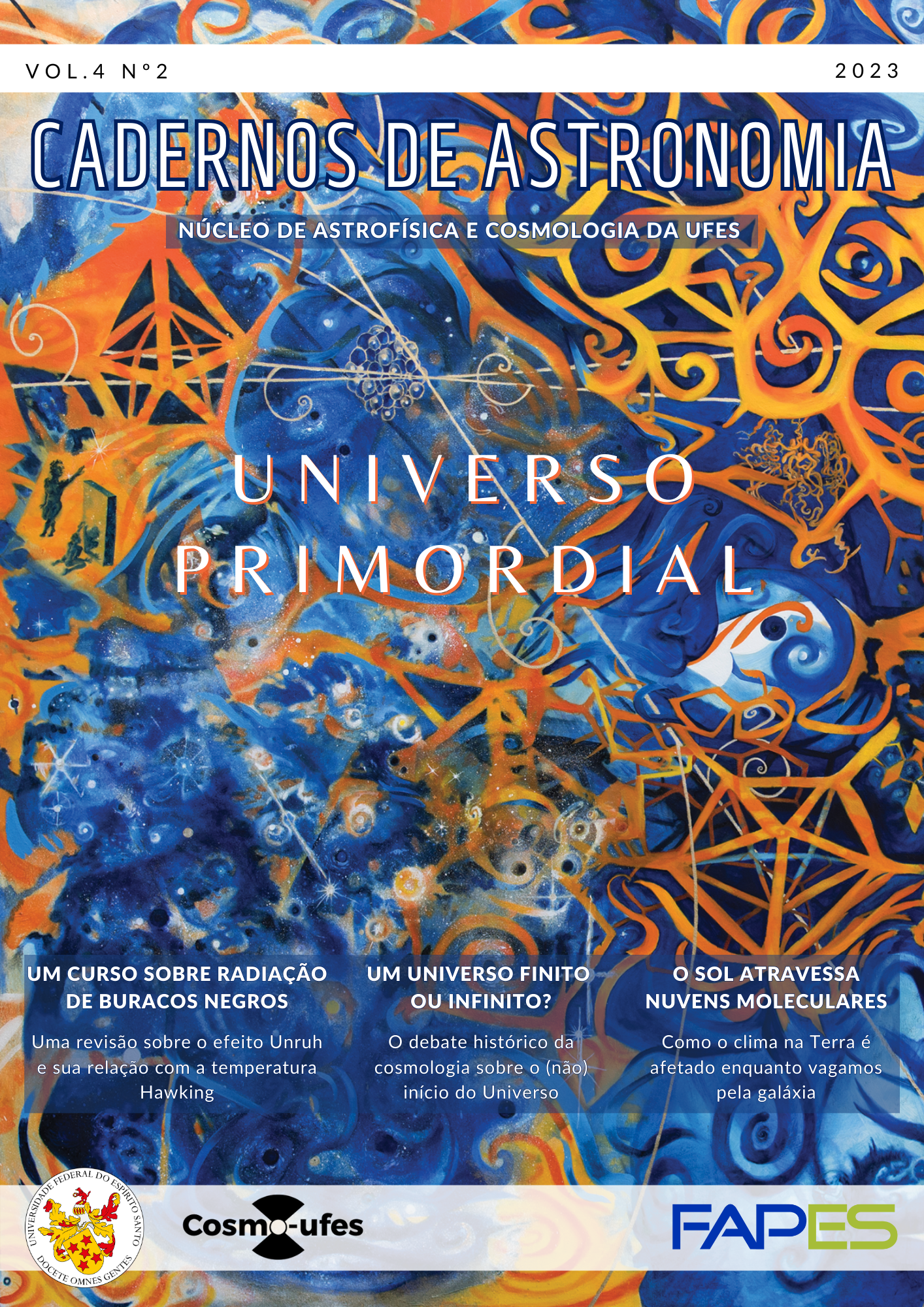Astronomy and Cosmology in research: a bibliometric analysis
un análisis bibliométrico
DOI:
https://doi.org/10.47456/Cad.Astro.v4n2.41644Keywords:
science, scientific community, astronomy education, interdisciplinarity, bibliometricsAbstract
"Cadernos de Astronomia" is a periodical publication dedicated to scientific dissemination, the history of science, teaching and research in astronomy and related areas. Aimed at serving a wide audience, the magazine focuses on scientific knowledge related to astronomy, cosmology and gravitation. In this study, with a qualitative bias, we sought to analyze the journal's publications in a specific period of time. To carry out a systematic review, six different categories of articles were adopted. To approximate the way in which scientists have been producing their results, two databases, Scopus and Web of Science, were accessed. The "Primordial Universe" was considered as a research topic in these databases. After the analysis of the selected articles, it was possible to reflect on the importance of scientific communities for the continuity of the development of scientific research. Since the teaching of astronomy has been integrated into the secondary school curriculum from 2022, it is believed that the scientific output of the journal has great potential to assisting teachers in their pedagogical practices.
Downloads
References
Ministério da Educação, Base nacional comum curricular (2018). Disponível em http://basenacionalcomum.mec.gov.br, acesso em mai. 2023.
L. C. Jafelice, O ensino de Astronomia Cultural: por quem, para quem, como e para quê?, in Anais do IV Simpósio Nacional de Educação em Astronomia (2016). Disponível em https://www.sab-astro.org.br/wp-content/uploads/2018/04/SNEA2016_M1_Jafelice.pdf, acesso em ago. 2023.
A. F. P. Martins, História e Filosofia da Ciência no ensino: há muitas pedras nesse caminho..., Caderno Brasileiro Ensino Física 24(1), 112 (2007). Disponível em https://periodicos.ufsc.br/index.php/fisica/article/view/6056/12761.
T. C. de Mello Forato, A Natureza da Ciência como Saber Escolar: um estudo de caso a partir da história da luz, Tese de Doutorado, Faculdade de Educação, Universidade Federal de São Paulo (2009).
J. B. Ferreira et al., Diversidade e gênero no contexto organizacional: um estudo bibliométrico, Rev. Pens. Cont. Adm. 9(3), 45 (2015).
I. M. W. da Silva Coelho, Métodos sistemáticos de revisão de literatura científica: apontamentos para o desenvolvimento e publicação de pesquisas educacionais, Educitec 9, 216523 (2023).
B. Kitchenham e S. Charters, Guidelines for performing Systematic Literature Reviews in Software Engineering, Relatório técnico da EBSE (2007). Disponível em https://www.elsevier.com/__data/promis_misc/525444systematicreviewsguide.pdf, acesso em ago. 2023.
K. Petersen et al., Systematic Mapping Studies in Software Engineering, in Proceedings of the 12th International Conference on Evaluation and Assessment in Software Engineering (2008), vol. 17. Disponível em https://www.researchgate.net/publication/228350426_Systematic_Mapping_Studies_in_Software_Engineering, acesso em ago. 2023.
M. Kuhrmann, D. M. Fernández e M. Daneva, On the Pragmatic Design of Literature Studies in Software Engineering: An Experience-based Guideline, Empir. Softw. Eng. 22(6), 2852 (2017). ArXiv:1612. 03583.
E. Farahmand et al., Five Decades of Scientific Development on ’Attachment Theory’: Trends and Future Landscape, Pertanika Journal of Social Sciences and Humanities 26(3), 2145 (2018). Disponível em http://www.pertanika.upm.edu.my/pjssh/browse/regular-issue?article=JSSH-S0898-2018, acesso em ago. 2023.
R. A. S. Leite et al., Bibliometria como trilha de conhecimento e pesquisa (Atena, Ponta Grossa, 2021), 405–417.
F. Quevedo-Silva et al., Estudo Bibliométrico: Orientações sobre sua Aplicação, Rev. Bras. Mark. 15(2), 246 (2016).
J. M. G. de Medeiros e M. A. V. Vitoriano, A evolução da bibliometria e sua interdisciplinaridade na produção científica brasileira, Rev. Digit. Bibl. e Cienc. Inf. 13(3), 491 (2015).
I. C. A. Fazenda, Interdisciplinaridade - Um projeto em parceria (Edições Loyola, São Paulo, 1991).
R. A. Martins, O Universo: Teorias Sobre sua Origem e Evolução (Livraria da física, São Paulo, 2012).
I. Roditi, Dicionário Houaiss de física (Objetiva, Rio de Janeiro, 2005).
J. C. Fabris, J. D. Toniato e H. Velten, Gravitação (Livraria da Física, São Paulo, 2021).
L. Paulucci, P. H. R. S. Moraes e J. E. Horvath, A Cosmologia na sala de aula (Livraria da física, São Paulo, 2022).
P. Russo, Astronomia, Educação e Sociedade, in V Simpósio Nacional de Educação em Astronomia (2018).
Planck Collaboration, Planck 2018 results. VI. Cosmological parameters, Astronomy & Astrophysics 641, A6 (2020). ArXiv:1807.06209.
Downloads
Published
How to Cite
Issue
Section
License
Copyright (c) 2023 Lucas Antonio Xavier, Sra Chirlei, Sra Simone

This work is licensed under a Creative Commons Attribution 4.0 International License.






